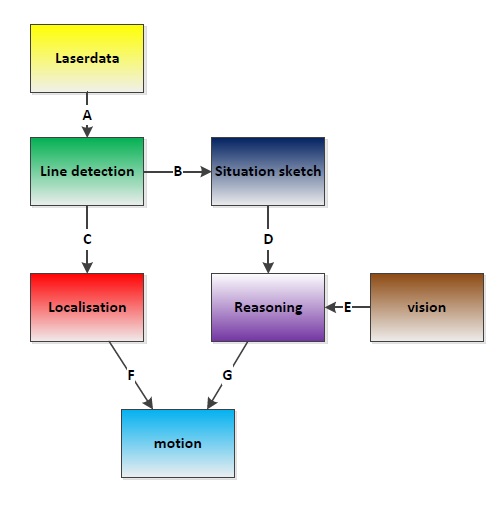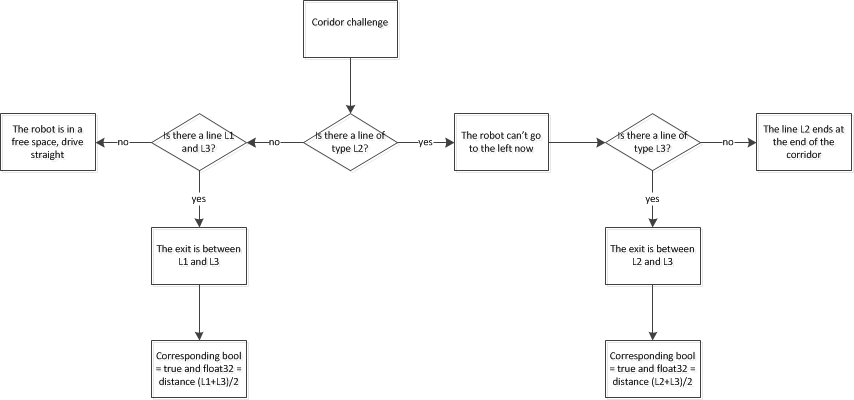Embedded Motion Control 2013 Group 1: Difference between revisions
Jump to navigation
Jump to search
mNo edit summary |
|||
| Line 117: | Line 117: | ||
| style="width:5%" style="background: #D3D3D3;" | '''#''' | | style="width:5%" style="background: #D3D3D3;" | '''#''' | ||
| style="width:15%" style="background: #D3D3D3;" | '''Datatype''' | | style="width:15%" style="background: #D3D3D3;" | '''Datatype''' | ||
| style="width:15%" style="background: #D3D3D3;" | ''' | | style="width:15%" style="background: #D3D3D3;" | '''Published by''' | ||
| style="width:15%" style="background: #D3D3D3;" | '''Topic''' | | style="width:15%" style="background: #D3D3D3;" | '''Topic''' | ||
| style="width:50%" style="background: #D3D3D3;" | '''Description''' | | style="width:50%" style="background: #D3D3D3;" | '''Description''' | ||
| Line 123: | Line 123: | ||
| A | | A | ||
| [http://docs.ros.org/api/sensor_msgs/html/msg/LaserScan.html LaserScan] | | [http://docs.ros.org/api/sensor_msgs/html/msg/LaserScan.html LaserScan] | ||
| | | Pico | ||
| | | /pico/laser | ||
| Laser scan data. For info click [http://docs.ros.org/api/sensor_msgs/html/msg/LaserScan.html here] | |||
|- | |- | ||
| B | | B | ||
| [http://docs.ros.org/api/std_msgs/html/msg/Int32MultiArray.html Int32MultiArray] | | [http://docs.ros.org/api/std_msgs/html/msg/Int32MultiArray.html Int32MultiArray] | ||
| | | lineDetector | ||
| | | /HoughLines | ||
| Every 4 elements represent a line element i.e. [x,y,x',y',...] with a maximum of 5 lines. Hence the array will at most contain 20 elements. | |||
|- | |- | ||
| C | | C | ||
| [http://docs.ros.org/api/std_msgs/html/msg/Int32MultiArray.html Int32MultiArray] | | [http://docs.ros.org/api/std_msgs/html/msg/Int32MultiArray.html Int32MultiArray] | ||
| | |||
| | | | ||
| | | | ||
| Line 139: | Line 142: | ||
| Custom message (3x [http://docs.ros.org/api/std_msgs/html/msg/Bool.html booleans], 1x [http://docs.ros.org/api/std_msgs/html/msg/Float32.html Float32]) | | Custom message (3x [http://docs.ros.org/api/std_msgs/html/msg/Bool.html booleans], 1x [http://docs.ros.org/api/std_msgs/html/msg/Float32.html Float32]) | ||
| | | | ||
| | |||
| | | | ||
|- | |- | ||
| E | | E | ||
| | |||
| | | | ||
| | | | ||
| Line 148: | Line 153: | ||
| F | | F | ||
| Custom message (3x [http://docs.ros.org/api/std_msgs/html/msg/Float32.html Float32]) | | Custom message (3x [http://docs.ros.org/api/std_msgs/html/msg/Float32.html Float32]) | ||
| | |||
| | | | ||
| | | | ||
| Line 153: | Line 159: | ||
| G | | G | ||
| Custom message (2x [http://docs.ros.org/api/std_msgs/html/msg/Float32.html Float32]) | | Custom message (2x [http://docs.ros.org/api/std_msgs/html/msg/Float32.html Float32]) | ||
| | |||
| | | | ||
| | | | ||
Revision as of 12:39, 24 September 2013
Group Info
| Name: | Abbr: | Student id: | Email: |
| Groupmembers (email all) | |||
| Paul Raijmakers | PR | 0792801 | p.a.raijmakers@student.tue.nl |
| Pieter Aerts | PA | 0821027 | p.j.m.aerts@student.tue.nl |
| Wouter Geelen | WG | 0744855 | w.geelen@student.tue.nl |
| Frank Horstenbach | FH | 0792390 | f.g.h.hochstenbach@student.tue.nl |
| Niels Koenraad | NK | 0825990 | n.j.g.koenraad@student.tue.nl |
| Tutor | |||
| Jos Elfring | n.a. | n.a. | j.elfring@tue.nl |
Meetings
(Global) Planning
Week 1 (2013-09-02 - 2013-09-08)
- Installing Ubuntu 12.04
- Installing ROS Fuerte
- Following tutorials on C++ and ROS.
- Setup SVN
Week 2 (2013-09-09 - 2013-09-15)
- Discuss about splitting up the team by 2 groups (2,3) or 3 groups (2,2,1) to whom tasks can be appointed to.
- Create 2D map using the laser scanner.
- Start working on trying to detect walls with laser scanner.
- Start working on position control of Jazz (within walls i.e. riding straight ahead, turning i.e. 90 degrees).
- Start thinking about what kind of strategies we can use/implement to solve the maze (see usefull links).
Week 3 (2013-09-16 - 2013-09-22)
- Start work on trying to detect openings in walls.
- Start working on code for corridor competition.
- Continue thinking about maze solving strategy.
Week 4 (2013-09-23 - 2013-09-29)
- Decide which maze solving strategy we are going to use/implement.
Week 5 (2013-09-30 - 2013-10-06)
- To be determined.
Week 6 (2013-10-07 - 2013-10-13)
- To be determined.
Week 7 (2013-10-14 - 2013-10-20)
- To be determined.
Week 8 (2013-10-21 - 2013-10-27)
- To be determined.
Progress
Week 2
State diagram made of nodes Localisation and Situation
Software architecture
IO Data structures
| # | Datatype | Published by | Topic | Description |
| A | LaserScan | Pico | /pico/laser | Laser scan data. For info click here |
| B | Int32MultiArray | lineDetector | /HoughLines | Every 4 elements represent a line element i.e. [x,y,x',y',...] with a maximum of 5 lines. Hence the array will at most contain 20 elements. |
| C | Int32MultiArray | |||
| D | Custom message (3x booleans, 1x Float32) | |||
| E | ||||
| F | Custom message (3x Float32) | |||
| G | Custom message (2x Float32) |
Software development
localisation code
(matlab generated)
clc %%x is driving direction!
Y1_1=-5; X1_1=-2;
Y1_2=-6; X1_2=6;
Y2_1=6;
X2_1=-5;
Y2_2=5; X2_2=-6;
rc1=(X1_1-X1_2)/(Y1_1-Y1_2) %%of left-hand line
rc2=(X2_1-X2_2)/(Y2_1-Y2_2) %%of right-hand line
%%##determine relative driving angle
Theta=tan(rc1+rc2)/2
%%##determine distance to left wall
offset1=X1_1-Y1_1*rc1;
Y1=-offset1/rc1
%%##determine distance to right wall
offset2=X2_1-Y2_1*rc2;
Y2=-offset2/rc2
Theory
include hough transform here


